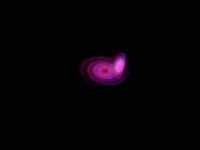Kepler_10b is the first confirmed rocky exoplanet, discovered using NASA磗 Kepler space telescope. As of January 2011, it is the smallest known transiting exoplanet, with a mass of 4.6 Earth masses and a radius of 1.4 Earth radii. Using data from Kepler, the W.M. Keck Observatory confirmed the existence of Kepler_10b using radial velocity measurements obtained with the HIRES instrument. Kepler_10b is the first definitively rocky exoplanet. Though CoRoT_7b was discovered before Kepler_10b and has been claimed to be rocky, there is more room for other interpretations in the case of CoRoT_7b磗 composition than there is for Kepler_10b. This is indicated in the plot to the left, which shows the range of masses and radii consistent with the observations of each planet and curves of compositions implied by those masses and radii. Although Kepler_10b is much too hot to harbor life as we know it, the discovery of Kepler_10b is an important step though towards finding planets that could harbor life. The high signal to noise of the Kepler_10b detection is a promising indication that the Kepler mission will be able to detect even smaller exoplanets, including detection of a rocky planet similar to our own.
Details
WebID:
C00605505
Clip Type:
RM
Super High Res Size:
1280X720
Duration:
001:50.000
Format:
QuickTime
Bit Rate:
29 fps
Available:
download
Comp:
200X112 (0.00 M)
Model Release:
NO
Property Release
NO













 Loading
Loading